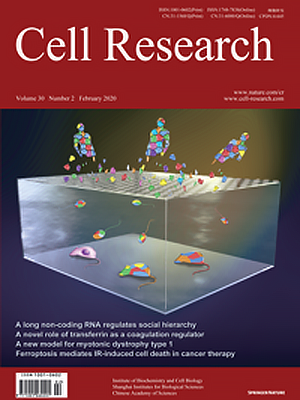
Advanced Search
Submit Manuscript
Advanced Search
Submit Manuscript
Volume 30, No 2, Feb 2020
ISSN: 1001-0602
EISSN: 1748-7838 2018
impact factor 17.848*
(Clarivate Analytics, 2019)
Volume 30 Issue 2, February 2020: 133-145 |
Qi Yin1, Hongye Wang2, Na Li 1,3, Yifu Ding1, Zhenfei Xie1, Lifang Jin 1,4 , Yan Li 2, Qiong Wang2, Xinyi Liu5, Liuqing Xu5, Qing Li1, Yongjian Ma1, Yanbo Cheng1, Kai Wang1, Cuiqing Zhong1, Qian Yu6, Wei Tang6, Wanjin Chen5, Wenjun Yang1, Fan Zhang7, Chen Ding7,Lan Bao2, Bin Zhou2, Ping Hu 2,8 and Jinsong Li 1,9
1State Key Laboratory of Cell Biology, Shanghai Key Laboratory of Molecular Andrology, CAS Center for Excellence in Molecular Cell Science, Shanghai Institute of Biochemistry and Cell Biology, Chinese Academy of Sciences, University of Chinese Academy of Sciences, Shanghai 200031, China; 2 State Key Laboratory of Cell Biology, CAS Center for Excellence in Molecular Cell Science, Shanghai Institute of Biochemistry and Cell Biology, Chinese Academy of Sciences, University of Chinese Academy of Sciences, Shanghai 200031, China; 3Shanghai University of Medicine and Health Sciences affiliated Jiading District Central Hospital, Shanghai Key Laboratory of Molecular Imaging, School of Medical Technology, Shanghai University of Medicine and Health Sciences, Shanghai 201318, China; 4College of Life Science of Shaoxing University, Shaoxing, Zhejiang 312000, China; 5Department of Neurology and Institute of Neurology, First Affiliated Hospital, Fujian Medical University, Fuzhou, Fujian 350005, China; 6Animal Core Facility, CAS Center for Excellence in Molecular Cell Science, Shanghai Institute of Biochemistry and Cell Biology, Chinese Academy of Sciences, University of Chinese Academy of Sciences, Shanghai 200031, China; 7State Key Laboratory of Genetic Engineering, Human Phenome Institute, Institutes of Biomedical Sciences, School of Life Sciences, Zhongshan Hospital, Fudan University, Shanghai 200032, China; 8Institute for Stem Cell and Regeneration, Chinese Academy of Sciences, Beijing 100101, China and 9School of Life Science and Technology, Shanghai Tech University, Shanghai 201210, China
https://doi.org/10.1038/s41422-019-0264-2